Isle Royale, Day 8: 24 Miles to Moskey Basin
Soft pinks and purples swirled above the chilled fog on Lake Siskiwit. Shivering through my sweaty shirt I continued to pump water from the swampy inlet on the western shoreline. It was early, still thirty minutes before the sunrise, and I had made darn good time this morning. Close to four miles lay behind me and soon I'd be back on Ishpeming Point before making my way east towards Mount Siskiwit and Chickenbone Lake.
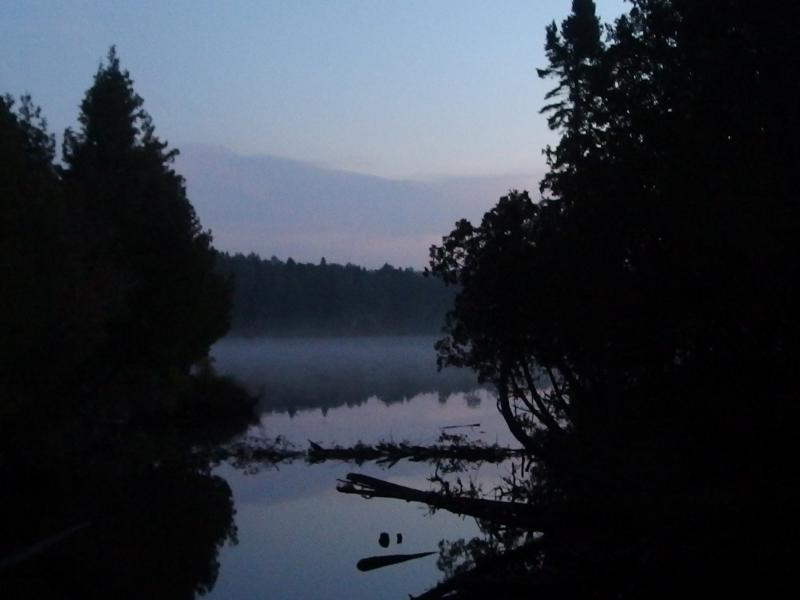
Cool morning light over Lake Siskiwit
My alarm had woken me up hours ago at Malone Bay and, after a quick scurry of packing, I was ready to leave by five. There were still options I could have explored today -bushwhacking to Chippewa Harbor or asking some boaters for a ride east - but that would have been cheating. I wanted to hike the twenty-four miles to Moskey Basin and finish my planned route. Before heading out I took one last look over the bay, timed and captured a flash from the lighthouse on Menagerie Island, and then started out on the dark trail.
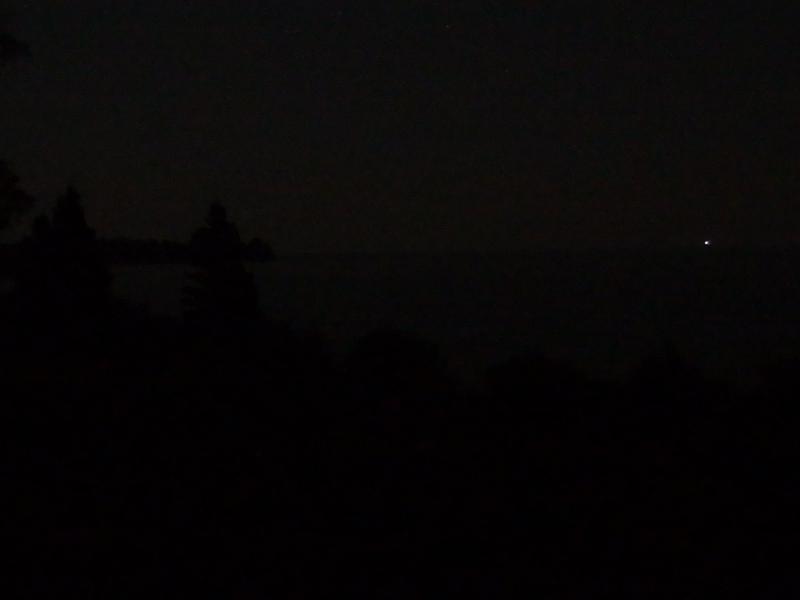
Lighthouse flash from Menagerie Island
An hour and a half of hiking in the dark took me to the end of Siskiwit Lake and where I stopped to filter water. Four miles of careful footsteps, jumping at shadows, and listening to every little noise with cautious intensity. Night hiking is something that always sounds like a good idea and then leaves me frightened and doubtful after the first few steps. When it's all done, though, as I sat on the bridge and filtered water and knew that I was halfway to Ishpeming Point before the sun was even up, I felt confident that the early start had been worth it. Only now that it's done.
There was still that climb to tackle. Yesterday, when I had came down from the ridge above, I had traveled over rocky bluffs, through birch forests, crossed grassy clearings, and waded through overgrown shrubs, all before even seeing Siskiwit Lake. Now I had to do it in reverse. With one last look around the swampy inlet for the two moose I had seen here a mere fourteen hours ago I stood up, straightened out my rain pants, pulled my backpack on, and started north on the boardwalk.
Around twenty miles left for today. I felt pretty good about it. Sure, I had to climb up Ishpeming Point, some seven hundred feet above me, and then hike a few roller coasters eastwards, but my body felt ready. The heels didn't hurt anywhere as bad now that I started bandaging them and changing socks throughout the day. My sunburnt hands were also doing mildly better and only bothered me at night. I played with the straps on my pack a few days ago and found a setting that fit perfectly, keeping the weight high on my back yet avoiding the sore shoulders I had been facing last week. I was managing just about everything except for a dull knot deep in my right calf that showed up yesterday afternoon. I tried stretching it this morning with limited success. My muscles were finally starting to rebel against their all-day usage.
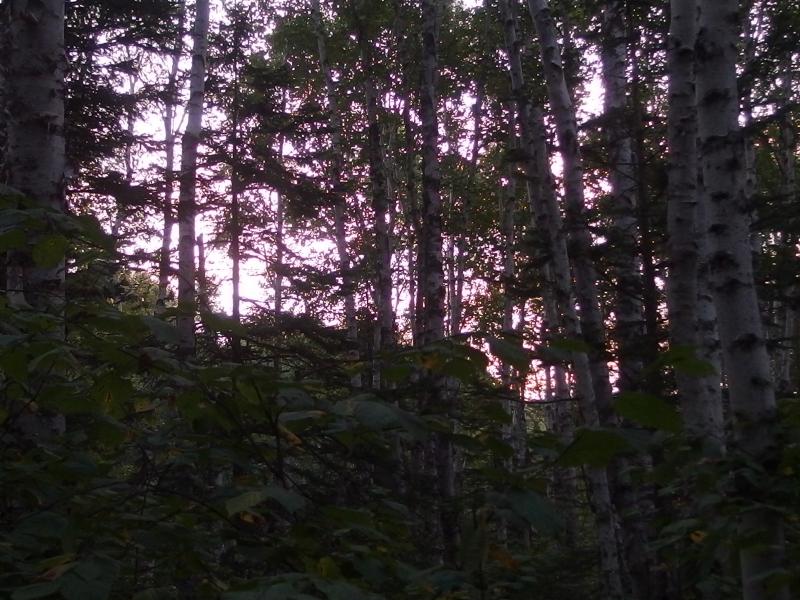
Bright morning light filtering through the birch forest
I walked through the overgrown swamp and started up a long, gradual climb through birch forests. To the right was a little cut, an unnamed stream that flowed down a deep gorge to the inlet I had just crossed, and some of the bright morning color began to filter through. There were no rock bluffs ahead that would offer me a sunrise view, no open clearings that looked eastward and broke free of the trees around it, yet I pushed myself on quickly. Sweat began to roll off of me in the cool morning air and I made sure to keep sipping water. The plan was to reach the Greenstone Ridge by eight and get back on unexplored trail.
When I had originally thought about this day, back when I was planning my route from the comfort of my office, I had thought about catching the sunrise from the western side of Siskiwit Lake. All I would have to do is wander a bit off-trail to watch it from above the far shoreline. That was before I saw just how dense the swamp was and how difficult wandering a bit off-trail would actually be. And the only unobstructed view off the trail was way near the top, the narrow opening that looked directly south. No, there would be no sunrise views today, not even with my early start. This morning was all about backtracking up the familiar trail as fast as possible and getting distance behind me.

Somewhere within a thick cloud
Something weird began to happen as I climbed. A white fog slowly enveloped me, wispy at first and slowly growing in intensity. The air felt fluffy and still in the fog. There was no hint of fog earlier this morning, just that dancing mist over Lake Siskiwit that was thin and crawled close to its surface. This was different. With a start I realized what had happened: I had walked right up into a cloud.
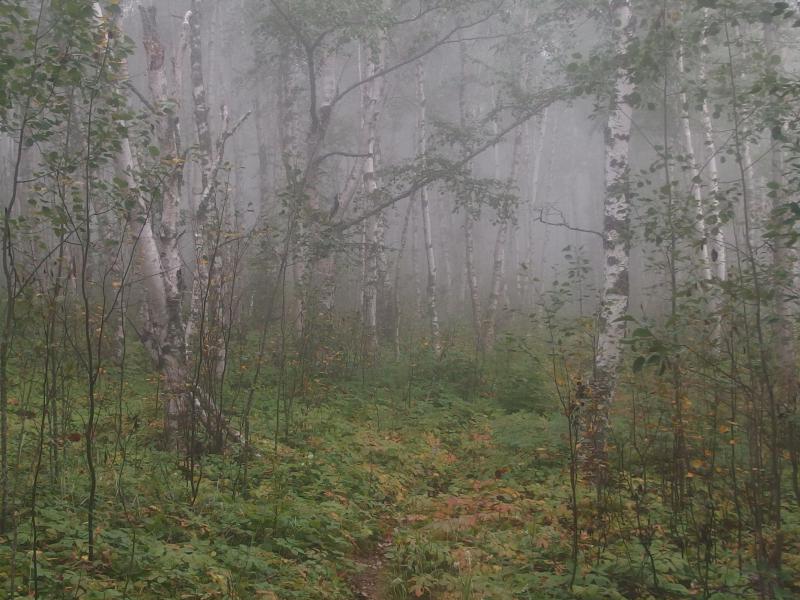
Hazy birch forest
The clouds made the trail, the boring trail that I was forced to backtrack up, quite a bit more interesting. Things disappeared fifty feet in the distance and forced me to be very aware of the immediate surroundings. There was no gazing ahead to determine the general direction of the trail, nor was there peering back from the rocky bluffs to try to make out far-off views. There was only the path stretching a dozen yards away from my feet and the mysterious forest beyond. I pushed forward, more cautious of my passage, and watched for familiar signs to determine how close I was. The thick cloud confused me, though, and it was with no small amount of surprise that I stumbled out underneath a short, squat observation tower.
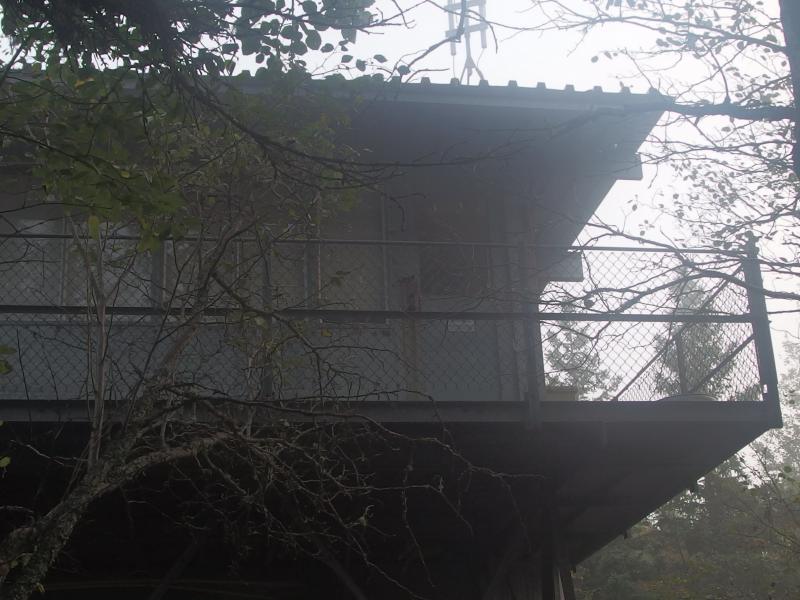
Misty tower on Ishpeming Point
Quickly stepping over to the wooden toolbox under the tower I dropped my gear and changed out of my wet clothes. The dew had thickened on the way up, probably due to the low-hanging cloud, and there were even a few little puddles up here. I'm not sure if it had actually rained around the tower or if things had just kinda collected, as dew does. I thought about breakfast. I had a half liter left, just enough for oatmeal and coffee, and decided to push that off. Breakfast could wait until I could refill my water.
Water was going to be a problem. The only guaranteed water source along this section of the Greenstone Ridge was Hatchet Lake, which lay a steep two hundred feet off the trail. I didn't want to waste that elevation, though that may be the only water over the next eleven miles. However, there were a few swamps that looked to drain across the trail beyond the junction to Hatchet. So I could burn elevation heading down to an inland lake or take a risk on swampy outlets. And if today's temperature was anything like yesterdays highs I would be needing a long water break.
With a quick, rolling gait, I started downhill from the disappointing observation tower. Seven miles down and four to go on the first leg of today's hike. After the climb out of Malone Bay I merely had to descend down to the junction with Hatchet Lake Trail, which also happens to continue on towards Todd Harbor and was the route that the Oscoda couple had taken off of the Minong five days earlier. Wow, I had been on the island a long time. Anyways, this descent is a bit of a ride, a few little rises here and there, but altogether drops over three hundred feet. I had assumed that after the early climb these four miles would be a cake walk.
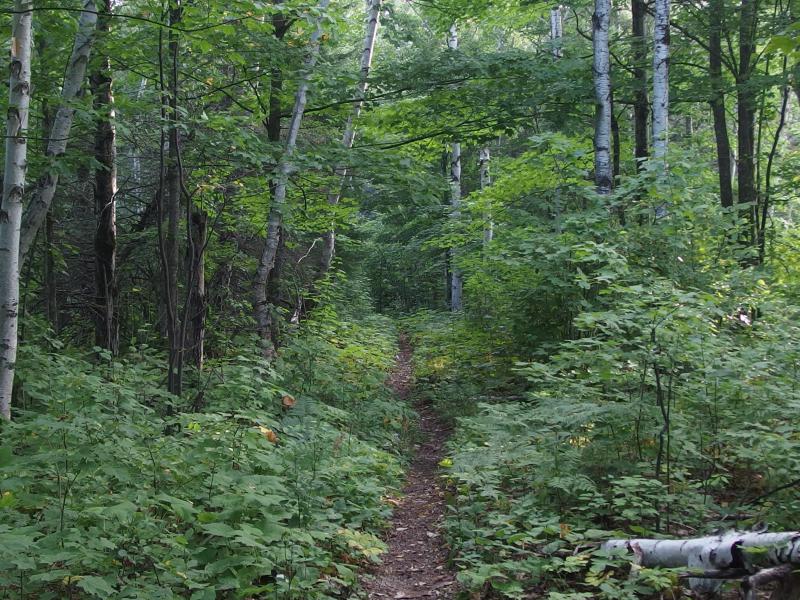
Undergrowth along the Greenstone Trail
My assumption was wrong. After thirty minutes of downhill slopes and short uphill climbs I was exhausted. I had downed a lot of snacks when I first started hiking, back along Siskiwit Lake, and then had been too busy huffing and puffing up the climb to continue eating. Now, with only a half liter of water left, I was hesitant on pulling out any more snacks. My stomach growled and I debated on taking a break at Hatchet Lake after all, a long rest with coffee and oatmeal and liters of fresh water.
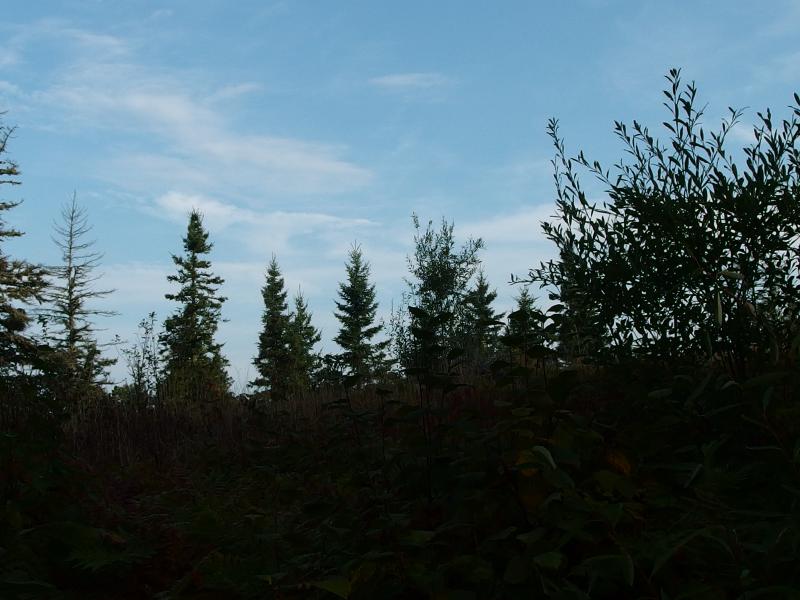
Skies clearing above
The skies above began to clear as I walked and a few outcroppings offered limited views around me. Today was indeed going to be a warm one. The temperatures were already starting to rise so far inland and no breeze blew across the ridge line yet.
An hour after leaving Ishpeming Point I met my first group of the day, four men heading west on the Greenstone Trail who had just left Hatchet Lake. At first they seemed really confused to see me, wondering where exactly I had come from. When I told them that I had spent last night at Malone Bay only one of them understood and was shocked that I had already clocked more than ten miles today. So was I - it hadn't really sunk in until then. They strongly urged me not to make the descent to the lake and told me that there is a flowing creek, one of my suspected swamp outlets, a few miles further up on the trail. I thanked them and wished them luck on their hike today before pushing on.
Now that I knew that a water source lay ahead I began to drink and snack again, trying my best to fuel up and wake up out of the tired funk I was slipping into. The terrain fought me with this. The trail come out on more open bluffs, bare rock underfoot slick from the dew, and I had to use my trekking poles to keep balance. It's not easy to try to eat and use poles, mostly because both activities require the use of your hands.
Speaking of trekking poles: after eight days on Isle Royale I was completely sold on them. In fact, I'm not sure that I could have made it this far without them. They had helped me recover from slips over wet rock, kept my balance on unsteady ground, and kept downhill pressure off of my too-fragile knees. Also, the poles had given me one heck of a speed boost, both over flat terrain and while climbing uphill. Even with my thirty-odd pound pack (I was eating about a pound a day, so my backpack was getting light by now) there were sections of the trail that I must have clocked over three miles an hour. It took several days to get used to them, to get the different rhythms down and have them slip into a comfortable second-nature status, but once they did I just ate up the trail.

Distant view down on Siskiwit Lake
When a nice view over Siskiwit Lake opened up I took a short pause and gazed southwards. Partly to enjoy the view and take a breather, mostly to plant the poles and eat some food unencumbered. There was a small island down there, just a bit to the east, and I wondered for a second which one it was. Then I noticed the slope of the land behind it and realized that it was either Eagle Nest or, more likely, the unnamed speck northeast of it. Which meant that the last hour of hiking of Greenstone had not even placed me level with Malone Bay.
That was the main attraction to the option of bushwhacking that I had debated last night. Malone Bay is near the center of the island, an island that is only forty-odd miles long. As the bird flies that meant that Rock Harbor is around twenty miles away, so why was I hiking thirty-six miles to reach it? Well, trails aren't as direct as flying birds, and the trail out of Malone Bay makes a giant loop out of the way. I still hadn't recovered from that and had miles to hike before I would that far east again.
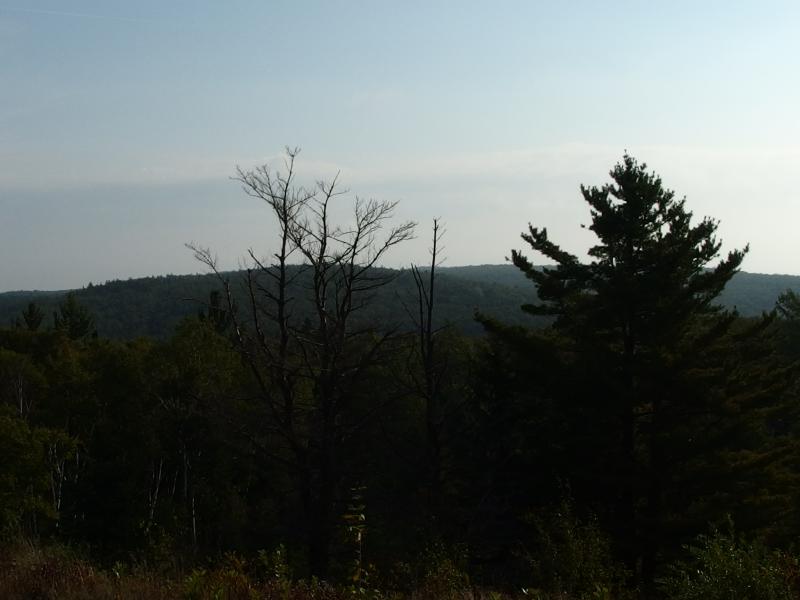
Low rises on the ridge ahead
The other view from this bluff were some low ridges ahead that confused me. I thought that the Greenstone Ridge was well-defined, yet the forest in front of me looked like a few rolling hills too low to have any sort of special distinction. Mount Siskiwit was supposed to be up there with strong topographic prominence and a steep northern bluff. Later I'd find out that this low hills were just in the way, that the ridge zags a bit to the left and was hidden behind the first hill. For now I stayed confused.
A few minutes after I started moving again and the sign for Hatchet Lake showed up. Just like Lake Desor from yesterday, the rocky bluffs and good views appear to be clustered around the trail junction. I took a quick look down the junction, saw nothing of interest, and continued past on the ridge trail. That creek had better show up soon - I had finished the last of my water while on the short pause overlooking Lake Siskiwit.
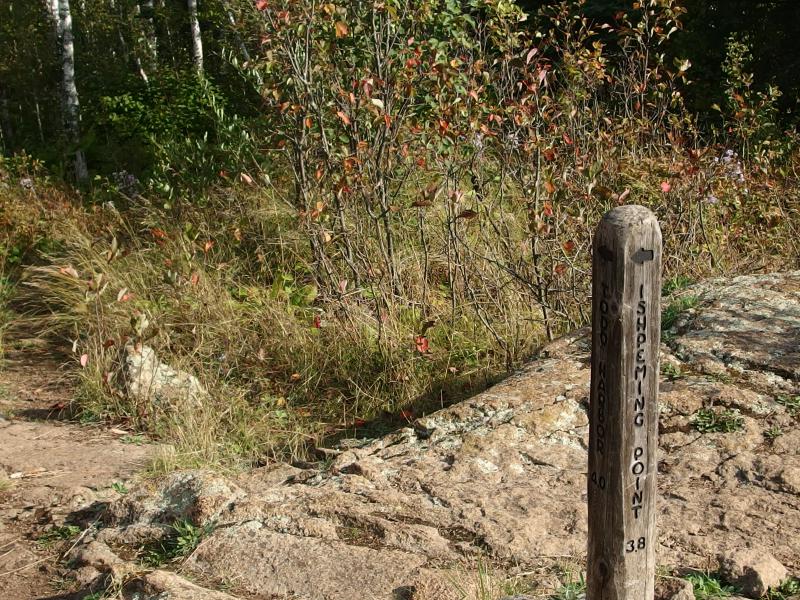
Junction to Hatchet Lake
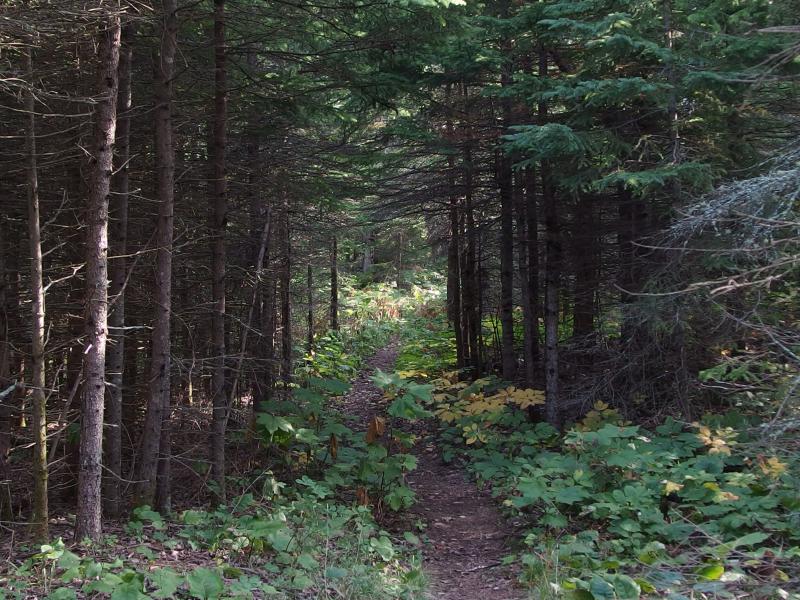
Close pine forest in the little valley
There was still more drop on the far side of the junction before the trail bottomed out through a pine lowland. I'm not sure why the split to Hatchet Lake didn't curve over this way and save some elevation difference. An extra quarter mile would have shrunk the height difference in half. As someone thru-hiking this section I would be much more willing to walk a bit longer than climb twice as far. Or maybe I was just getting too tired by now and was fishing for excuses to avoid walking any distance out of the way.
Last night I had picked two possible locations for water along the trail. The first was here, at the low point of the trail, though the saddle shape made it unlikely to hold a trickling creek. The second and more likely option was where a large swamp on the right side appeared to drain over the trail and pour down towards Hatchet Lake. This option was at least two miles beyond the trail junction and sat above an annoying climb. While this looked promising, and that group of four men seemed to validate my hope, I found it disconcerting that the map had no stream marked, no seasonal dashes or anything. Everything was based on just how the topo lines twisted in that area.
Beyond the pine forest the trail climbed up that annoying hill over rocky outcroppings and through tight forests. There were no views back on Hatchet Lake, something I had hoped to find, so I kept a fast pace and leaned heavily into the climb. I was tired and thirsty and hungry and began to throw all of my hope on this creek. Which wasn't a bad place to throw it, to be honest. It was the halfway point on the hike, half the distance to Moskey Basin, and it wasn't even close to noon yet. And, if everything fell through, there was nothing saying I couldn't wander a short distance off trail in search of water. Returning to Hatchet Lake was not an option.
The trail crested the hill, the first low hill I had seen before the junction, and slipped down and back up a few little dips before dropping down a valley quick enough to warrant switchbacks. Ahead I saw a group of hikers, four in all, and I soon caught up to them and threw out a greeting. The man in the back turned around and we had a short conversation, though the others didn't pause and wait for him. This seemed weird so, after a minute or two I wished him well so that he wouldn't get too far behind. Besides, there was something else in this valley that interested me more than conversation. A small, bubbling creek crossed the trail and beckoned to my dry state.
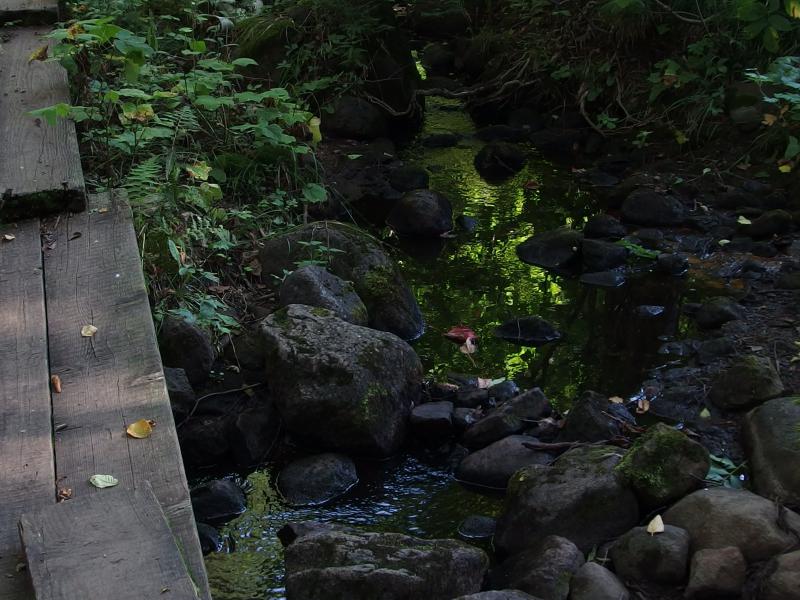
Tiny creek up on the rise
I plopped down next to the creek, pulled a liter, and soon had coffee brewing and oatmeal warming as I drank my fill. The water was blackened from the nearby swamp, organic sediment clinging to every rock like waving pennants and little pieces drifting pass, and I had to scrub out my filter after every liter to keep it flowing. It was an annoying process, especially with my still-tender sunburned hands, though I knew I had to drink as much as possible here. The next leg of the hike would leave me high and exposed to the midday sun.
Seven miles was the distance between Hatchet Lake and Chickenbone, and while I had already covered a few of those miles I couldn't underestimate the difficulty of the remainder. Mount Siskiwit rises to a height of 1205' and is composed of three separate peaks, though there are several smaller rises and little valleys scattered throughout. After yesterday's hot slog up Ishpeming Point I knew that this would not be easy, not with the temperatures that the interior of Isle Royale would probably reach today. There would be no other water on this section of the Greenstone Ridge, not until I dropped down the far side.
After downing a good two liters of water, eating oatmeal and drinking hot coffee, and then topping things off with a healthy amount of Nutella, peanut butter, and crispbread, I felt ready to continue on. Before this rest I had been exhausted, both my eyes and legs ready to call it quits for the day, and now I was confident and restless. In fact, as I headed up and away from the creek, I wondered if my hour break would be too long to catch up with those four hikers from earlier. There's always the chance that they stopped for a break ahead or that they would be moving a more leisurely (or reasonable) pace.
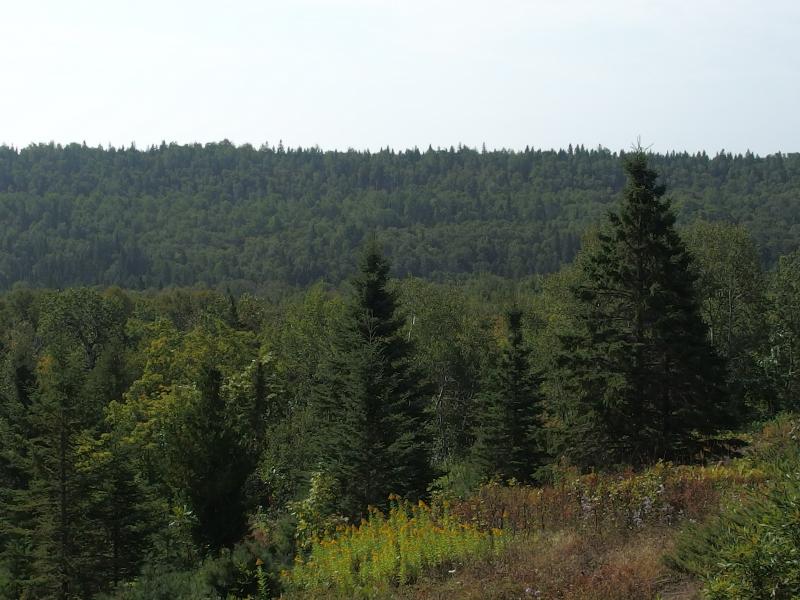
Nearby ridge
On the far side of the dark creek the trail shot up a quick little climb and emptied out on a few clearings with views to the south. I looked over, expecting to see a new angle on Lake Siskiwit, and instead saw a large green hill. That, that was unexpected. When looking at a map later in the evening I'd learn that this tall hill was just a random rise that sat next to the Greenstone Ridge proper, separated by swamps and lowlands, and that I'd soon be past it. For now it was just a weird obstacle that both blocked my view and confused my understanding of the island's geology.
I was happy to see the open clearings, though. Traveling from west to east on the Greenstone Ridge Trail did mean generally better views. The west side, around Sugar Mountain and Mount Desor, is heavily wooded and doesn't offer a lot of vistas, while the east side with Lookout Louise and Mount Ojibway is very rocky and open. There was evidence of this even on the abbreviated sections of the ridge I had been on so far. Mount Siskiwit was an unknown, though. It sat near the center of the island and stood an equal chance of being one long forested hill or a series of fantastic open clearings. The latter would be most excellent - being in the middle of the island should mean good views of just about everything on Isle Royale.
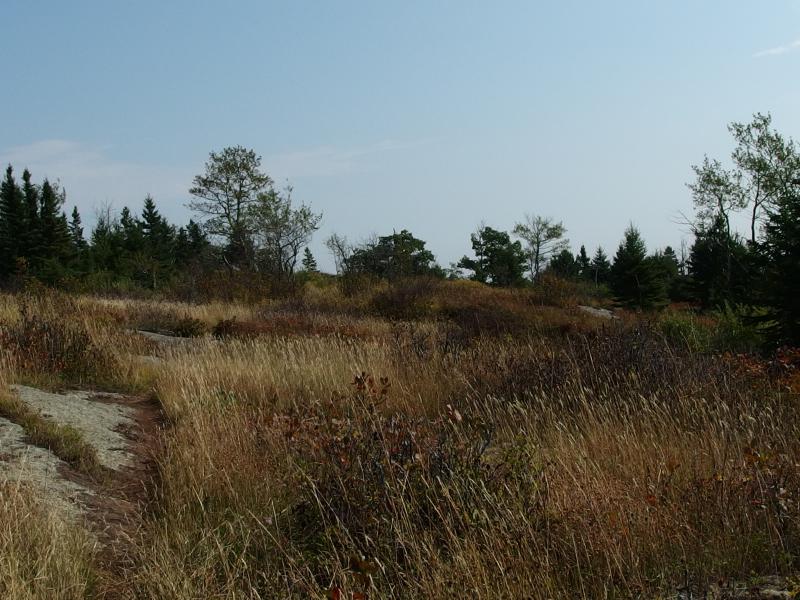
Grassy bluff on Mount Siskiwit
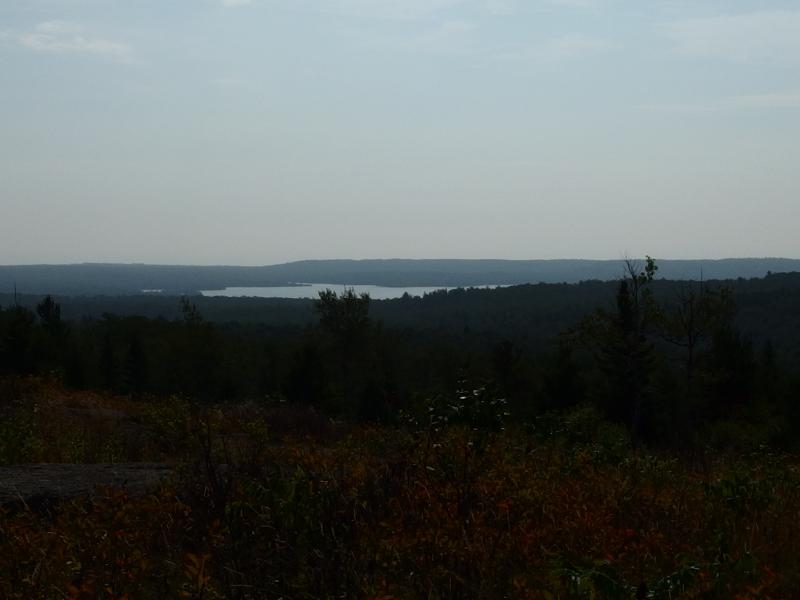
Eastern end of Lake Siskiwit
Twenty minutes later and another long clearing opened up and the southern view got better. I was already making it past that green obstacle and getting glimpses of Lake Siskiwit in the distance. Only the easternmost end of it was visible, the rest still blocked by the hill, but I squinted and tried to understand what I was seeing. A tiny cove in the background probably opened into Wood Lake, which is part of the Whittlesey/Chippewa portage path. Low hills rose up around that lake, though with the distance and hazy air it was hard to tell if they were bare rock on top or green forest. The rest of the shoreline swung in and out along different little bays and were hard to distinguish.
With this good of a view I had to be on the first peak already. I continued forward a short distance, looking around the open rocky clearing and cruising along, and soon bumped into an older gentleman sitting down and enjoying breakfast. We chatted very briefly - he was hard of hearing and seemed to prefer the silence to our talk. His pack did look familiar, though. He was one of the hikers I had seen earlier on, down by the creek. That's why the others hadn't waited around. All four were probably on their own. I just happened to see them before at a time when they were together.
I left the older man and started down the far side of the peak. It dropped quickly and entered a brightly-lit forest that was dangerously easy to cruise through. This leg was turning out to be much easier than I had expected. Sure, the temperatures had warmed up to create a hot and muggy summer afternoon. There was a breeze, though, that rustled the leaves and kept me comfortable. I snacked lightly, walked quickly, and enjoyed the quiet forest around me.

Bright green on Mount Siskiwit
The trail weaved a bit, climbed a few soft grades and dropped back down, and then suddenly opened out onto a broad south-facing bluff. Second peak. I paused and looked north first, up at the forest rising behind me. It wasn't obvious if there was a north-facing view or not. Which is too bad, because Lake Harvey and McCargoe Cove were two things in that direction that I had hoped to see today. To the south was a better angle on Siskiwit Lake, this time with Ryan Island in the forefront.
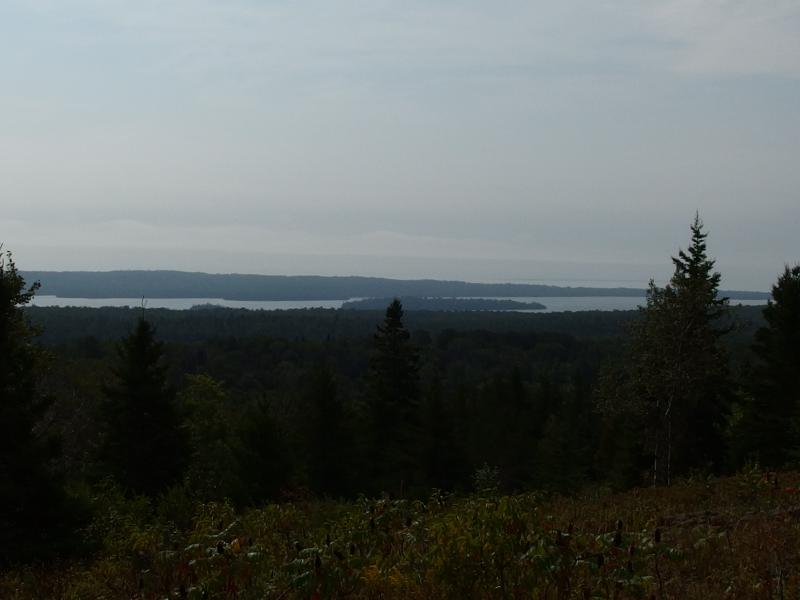
Looking back down on Ryan Island in Lake Siskiwit
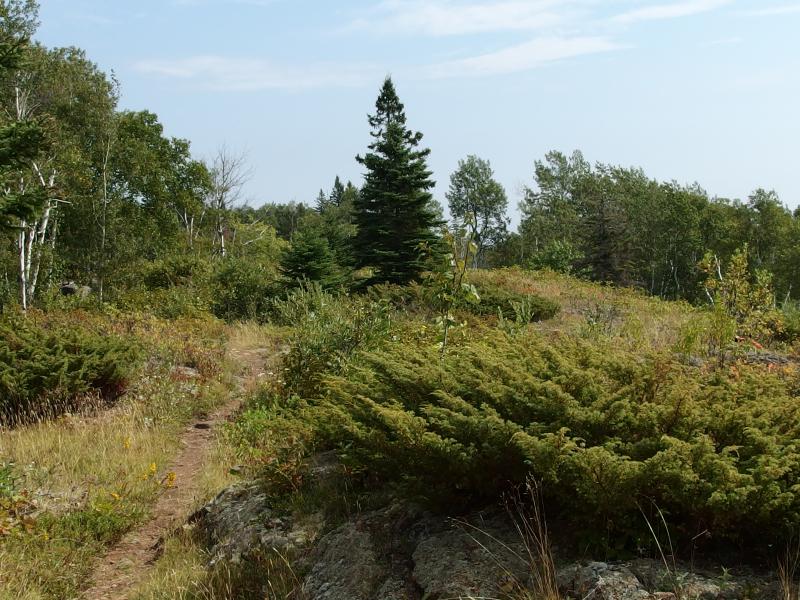
Winding path along the grassy ridgeline
Ryan Island is famous because, as many others have put it, it is the largest island in the largest inland lake (Lake Siskiwit) within the largest island (Isle Royale) in the largest freshwater lake (Lake Superior) in the world (by area). I've heard a rumor that there is a marshy pond on Ryan Island with a solitary rock sticking out to further the Russian nesting doll analogy. Anyways, I was glad to see it, as it had been hard to make out while down by Malone Bay. I was also glad to see how far east along Lake Siskiwit I had traveled. Finally starting to make some distance eastwards.
Walking down off the second peak was a quick and short event. Only a small dip separates this from the last major peak, a small dip with some forests and more grassy clearings. Along this section I passed the second man, this one taking pictures of surrounding trees, and I had to hail him to avoid stumbling into him and ruining his shot. This was the same man I talked to at the creek earlier, the short conversation about the trail ahead, and we joked briefly. And then I was off. I was excited to see what the next view had in store.
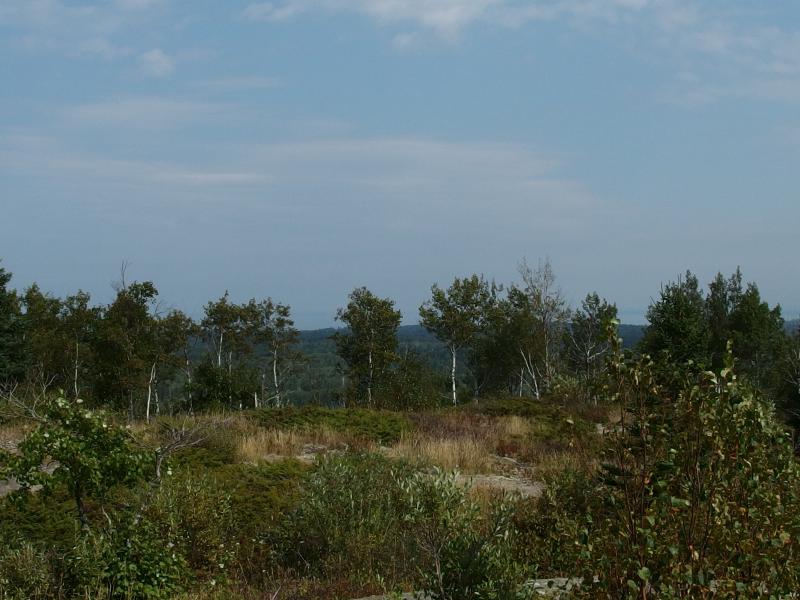
Only partial views to the north
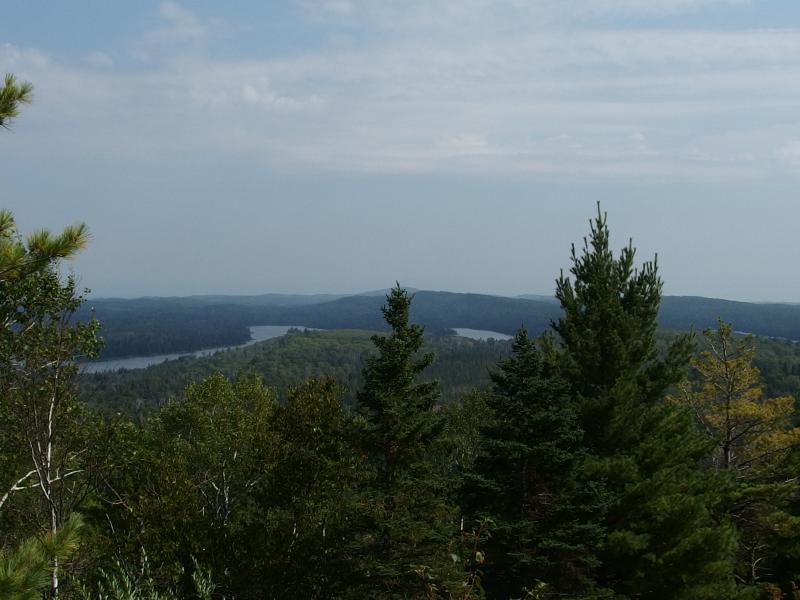
Scattered lakes shining to the northeast
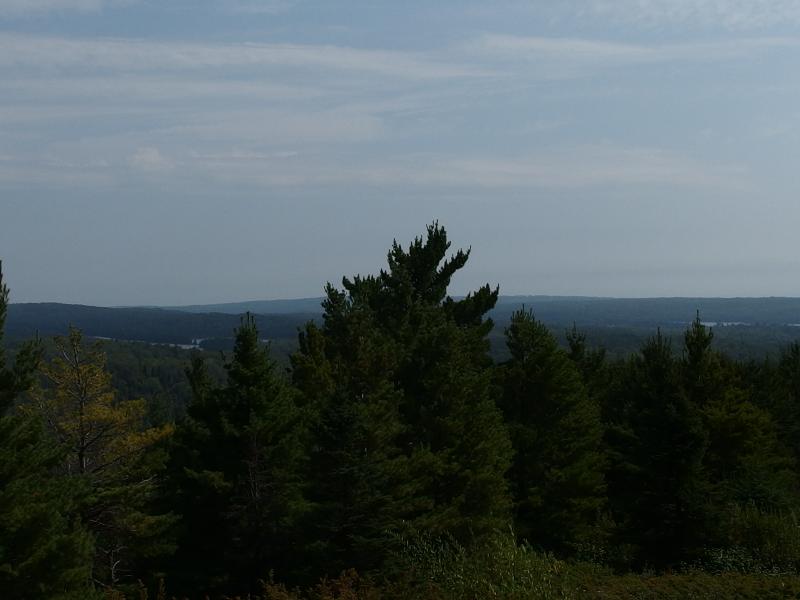
Teasing glimpses of blue over towards Moskey Basin
This time there was more to see then the limited southern shoreline. Now there were more lakes, some sprawled out ahead along the ridge and others hidden glimpses through trees. I gazed around and tried to figure out what they were. The large one on the left was probably Chickenbone, and Livermore sat next to it, with the Greenstone Ridge rising up just behind. The only problem was the inability to see the other half of Chickenbone. There should have been another leg reaching northeast, out towards McCargoe Cove, and I couldn't make it out. That was a bit disappointing.
Further to the right was also confusing. Lake Richie and LeSage are both large lakes, and Moskey Basin is only a few miles beyond Richie, yet all I could see over there were rolling green forests with hints of blue in between. Maybe the land over there was just too rugged and this peak not high enough to give me a better view. Either way, my time on this mountain was done. I could see the trail plunge down into the forest ahead, into the low swampy lands where the Greenstone Ridge disappeared for a few miles.
Plunge indeed did the trail, dropping down switchbacks into a dark, thick forest and making no pretense that the rocky ridge would not be be rising again soon. This is a strange piece of the Greenstone Ridge. Where other drops quickly picked back up, like the one between Mount Desor and Ishpeming Point, this valley was almost three miles long and straddled swampy lands between Chickenbone Lake and Lake Livermore. I wasn't too torn up with being done with the open ridgeline. On the far side of the valley, when things picked back up, was back where I had walked some six days ago on my way from Mount Ojibway to East Chickenbone. There was nothing new to see over there. It would soon be time to veer south on the Indian Portage Trail and start on a more curvy route towards Rock Harbor.
Mere minutes into the steep plunge and I bumped into the third and fourth hiker from earlier in the day, an older couple, and we started up a great conversation. We started with the now-normal discussion on our routes, about where we started from and where we were stopping (they were doing Hatchet Lake to West Chickenbone today and would soon be done for the day), and then quickly veered into other topics.
The husband had a great story about meeting a grizzly up in British Columbia which thoroughly beat my moose encounters out here. Then they learned that I was from Arizona and told me that they hiked the Grand Canyon every winter, backpacking down to Clear Creek for a few days and enjoying a large Christmas dinner at Phantom Ranch. By the time they decided to stop for a break and I continued onward my head was spinning with their tales and admiration of their many years enjoying the wilderness together.
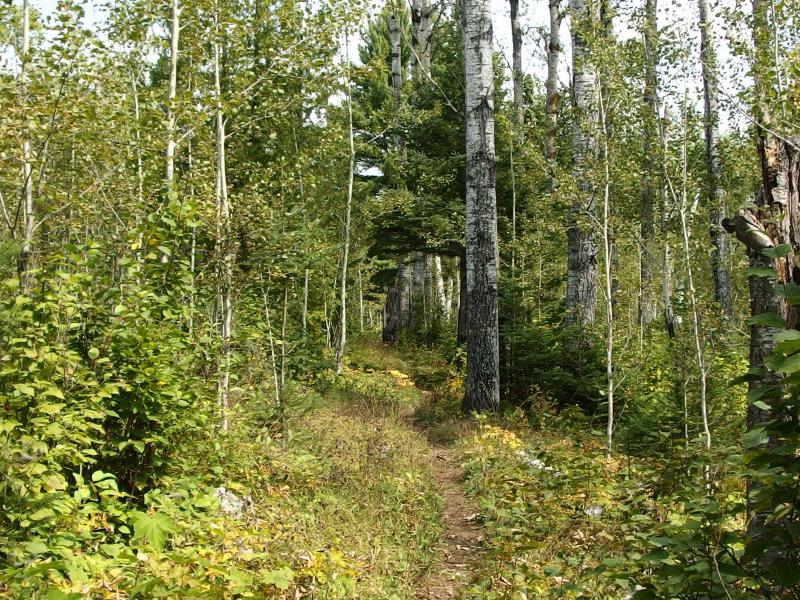
Swampy stretch along the Greenstone
Now it had been about two hours since I last stopped for water back at that little creek on the other side of Mount Siskiwit. I still had a half liter of water gurgling around and had done a good job at snacking as I hiked. I did pass by a beaver-dammed creek while talking with the older couple that I originally planned on filtering from but didn't want to pause their stories. Soon I'd be walking past cool inland lakes with plenty of water to pull from, anyways.
Before I came upon the trail junction, though, I bumped into a solo man hiking in the other direction. A man who was actually coming from Moskey Basin! Excited I asked him about the campsite ahead and the trail in order to learn as much as I could about my destination. What he told me was worrying. Last night every shelter had been stuffed with kayakers. He was forced to share one of the group sites with a handful of other backpackers.
Kayakers. I didn't factor that into my plans. See, I really wanted to have a shelter tonight. Part of me was hoping to spend my last night on Isle Royale in style and to have an easy morning packing up. Most of me had just gotten lazy after the last two nights sleeping in a shelter and didn't want to cram into my little tent again. I had been moving fast and hard on the trail today so that I could make it into Moskey Basin in time to claim a shelter. I figured that if I reached the campground before five then I'd be safe, especially after seeing most other hikers trickle in to sites closer to six. But I had no idea when kayakers pulled in their paddles.
I thanked the man, girded my loins, and pushed forward. Within minutes I came upon the junction, turned right, and zipped down a hill towards Lake Livermore. It was finally here, the final leg of the hike, and I had both the reason and energy to make it a quick one.
The third leg was just shy of six miles long. It skirted past two lakes before meeting up with Lake Richie, followed that lakes northern shoreline, and then cut a direct line over to Moskey Basin. That's all I knew about it when I started down the Indian Portage Trail. Well, I knew that parts of the trail were used as portages between the lakes and had made an assumption that these parts would be wide, level, and easy to cruise down. I was wrong about that.
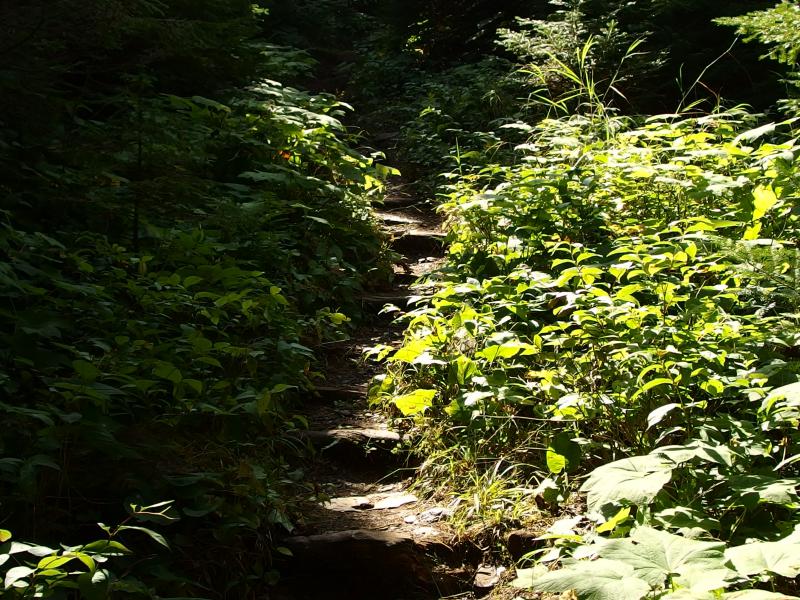
Stairs on the portage trail
Minutes after leaving the Greenstone the surroundings changed dramatically. From open, scrubby lands that were baking under the hot sun a deep, cool forest rose up near the shore of Lake Livermore. The trail didn't actually touch the lake itself and stayed some fifty feet above it. I thought briefly about dropping down on the portage connection and pump some fresh water and decided against it. There would be plenty of water a few miles further on.
Besides, just where the portage spur showed up something else appeared on the trail - rocky dirt stairs leading up a steep hill. It wasn't tall, maybe a hundred feet at most, but it was unexpected. I thought this leg was supposed to be flat and easy. With an unrelenting pace I zipped up the stairs and followed the winding trail.
And so began a long game. The path dropped and climbed, wound around and straightened, traveled dirt footpaths and over wooden boardwalks, went through tunnels of dense forest and opened into brushy forests. I felt more like I was on a roller coaster than a hike, or like I was wandering through a brushy maze on my way to an overgrown and magical Secret Garden. One portage spur after another showed up, designated only with a wooden post and the letter 'P', and more than once I wondered if I took the correct fork at some of the spurs. Sweat began to pour off of me as I moved ever faster on the rugged little trail.
Only one three-person group was heading the other way today, another group who had come from Moskey, and I was surprised at how late of a start they must have had. It was after two in the afternoon, so even if they were setting a slow pace they must have waited until noon before leaving their camp. They also told me that a lot of kayakers were in the shelters yesterday night, though it sounded like all of them had taken off this morning. I don't remember where these hikers were heading, either McCargoe or Hatchet, but I do recall that they had a rather hot and long afternoon ahead of them.
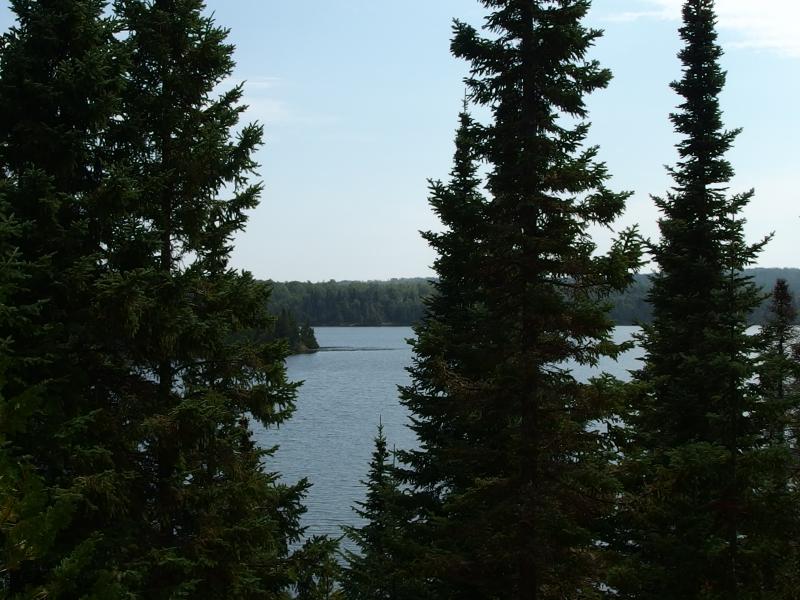
First view over Lake Richie
When I finally burst out onto Lake Richie my burst of energy was run out. It had already been one heck of a long day and that roller coaster didn't help much. I tumbled along the northern shoreline, which bucked up and down little rocky rises with annoying frequency, and slowly passed one island after another. Hastings Island, then Birch, and then one or two little ones that had no name faded in and out of the lake view. On the way I passed two men enjoying some peanut butter packs and, just beyond them, a nice rocky outcropping that dropped down to the water's edge. It was tempting, so tempting to stop and refill my water, and I chose to continue on instead. I really wanted that shelter.
The campground at Lake Richie passed by with little fanfare. I vaguely remember a few footpaths criss-crossing the main trail and maybe a camp map. My focus was on moving forward, though. Dull lethargy was settling in by now, an obvious sign that I should stop and rest and eat, a sign that I stubbornly ignored. The knot in my calf had grown and now gave me a slight limp that I tried to correct with my poles. My feet themselves, which had put up with a pounding on so many rocky ridges before, were complaining about the hard ground. None of it mattered; only the campground of Moskey Basin remained important.
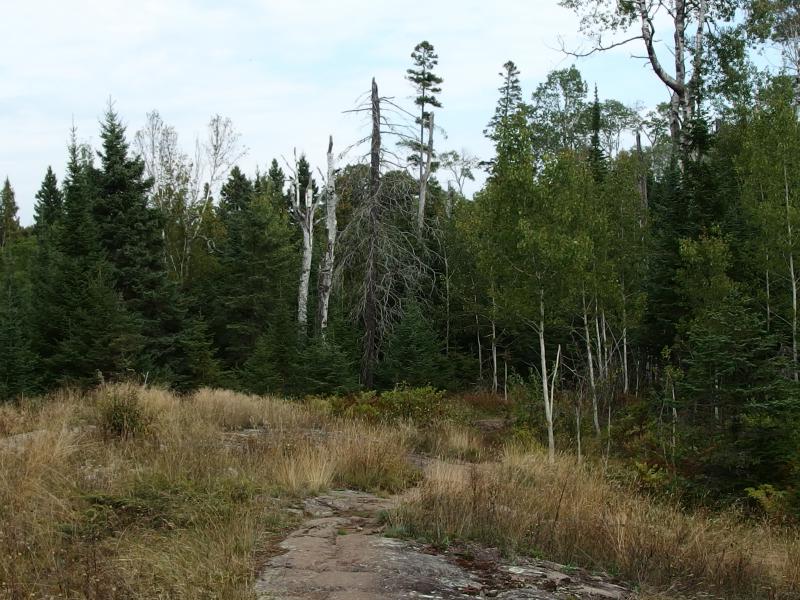
Rocky Trail to Moskey Basin
Long rocky ridges stretched between Lake Richie and Moskey Basin, hard rock underfoot that bucked and dipped like the frozen swells of a stormy sea. The sun beat down on the open clearings and baked everything on them, including me. I had finished the last of my water back on the Greenstone and was now licking dry lips with a dry tongue from a dry mouth. It wasn't bad - I was used to hiking dry miles in Arizona and hot Michigan summers before that - though it wasn't great either. I have a bad tendency to push myself a bit hard when the 'end is in sight', and already today I had passed several flowing creeks and lakes knowing that a campground would be around any one of these bends. One day I'll learn my lesson. Not today.
The rocky ridges gave way to thick, swampy forests, and I found myself wondering about Chippewa Harbor. I had been really tempted to either go through or even camp their tonight. Bushwhacking from Malone Bay would have dropped me off within a mile of that remote harbor or the boaters could have dropped me off there. I had a vision of what it was like, a less-remote Malone Bay at the end of a dead-end trail, which made it very tempting. It also would have added a cruel six miles onto my already-unreasonable Sunday hike. Still, I wondered if the trail was as bumpy as the Indian Portage Trail or Lane Cove, as it goes north-to-south like them, or if things calmed down so far south.
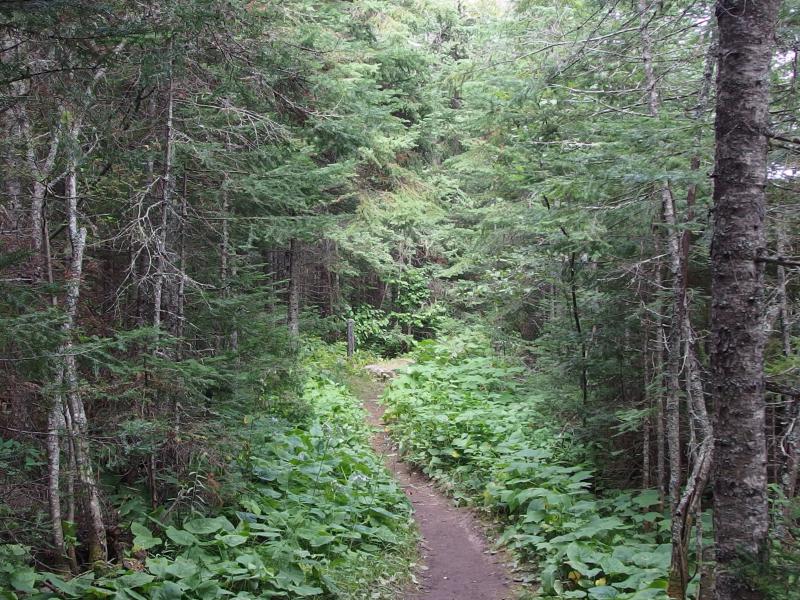
A welcomed junction ahead
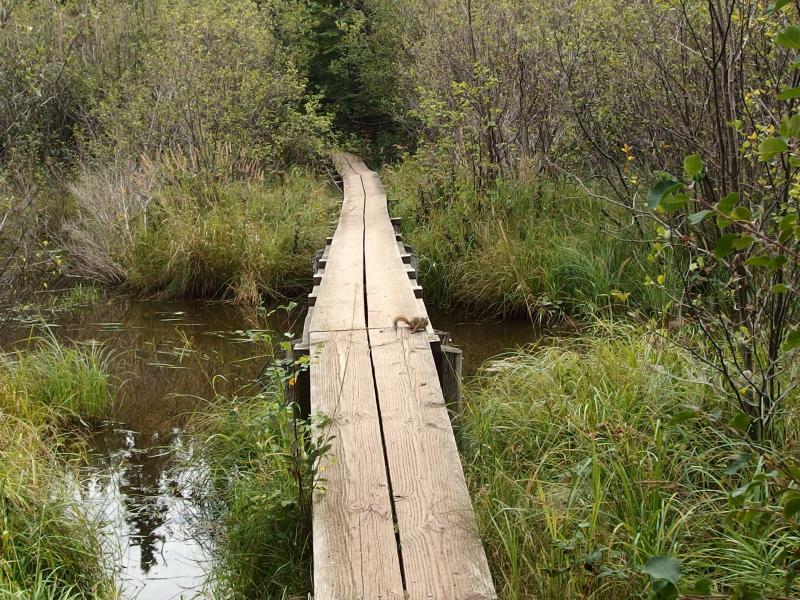
A brave chipmunk on the footbridge
A most welcome trail junction showed up ahead, I turned right, and quickly came upon a brave chipmunk guarding a bridge over a swampy little creek. I tried to let him pass and then tried to reason with him, but in the end I was forced to simply walk forward onto the bridge and bully him to the other side. On the far side things got confusing. There were a few forks that showed up immediately and I wandered to the right, backtracked, and then came back to the shoreline. Once I found a camp map I tried to orientate myself and find the shelters, which I sort of did, and then footpaths took over and meandered in between the different sites in a confusing maze. The first shelter I found was occupied so I wasted little time at claiming the second one, which sat a mere twenty feet from the lapping waters of Moskey Basin.
It was my last night on the island and I had a shelter. That, that was a relaxing thought. Today I had covered twenty-four miles in eleven hours, including several short breaks and that hour-long brunch before Mount Siskiwit, and my body was severely angry at me. With my pack resting on a picnic table I took out my filter and was starting down towards the water when a park ranger showed up and brusquely asked me for my itinerary.
At first I was excited to see her. This was the first ranger I had seen out in the woods since the boat at Lane Cove, and if anyone knew more about the recent trail work by Lake Siskiwit, or the abandoned station at Malone Bay, or the cabin ruins on Coyote Ridge, or any of the other questions I now had about Isle Royale it would be a ranger in the field. However, her abrupt manner put me off. She was here to check on itineraries, make sure no one was causing trouble at the camp, and move on. At least I still had mine, even after almost leaving it behind at Little Todd, and once I showed her it she quickly walked on to the next shelter.
After that encounter I holed up for awhile. I filtered water, drank, and then filtered some more. I dried out my sweaty clothes and took a quick, and surprisingly painful, swim in Lake Superior. Every muscle in my legs and back was on the verge of cramping up, my feet were sore, and the raw skin on my heels was unbelievably tender. After the swim I sat and dried out at the picnic table for some time and tried to move as little as possible.
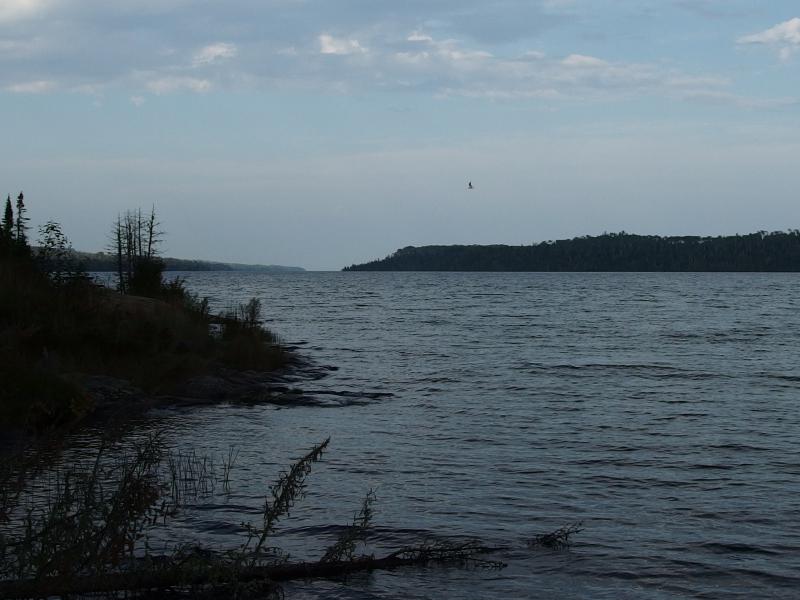
Long view down Moskey Basin

Brilliant colors overhead
Later, once all the little chores were done, dinner was done, and I was in dry camp clothes, things started sunk in. This was the last night. That was my last swim in Superior, the last time I would make dinner, and soon I'd see my last sunset from Isle Royale. Well, however much of the sunset I'd see, anyways. This bay opened up to the east. Feeling melancholy about the approaching end I decided to wander around a bit and try to find some people more friendly than that ranger. On sore feet I slowly walked up to the trail and headed back up, looking for welcoming faces, and had made it all the way to the docks near the camp entrance before I saw someone. Well, if it wasn't the boaters from Malone Bay!
They were just as surprised to see me. Turns out that they had tried to find me this morning to offer a ride to either Chippewa or here, as they were heading in a general Rock Harbor direction to refuel tomorrow anyways. We chatted a little bit about the hike and more about their watery journey, which had resulted in plenty of caught fish and a quick trip to Greenstone Beach, and they offered me some fresh fried fish. I turned it down, still stuffed from dinner, and after some more banter we separated. They had opened up another option for me, to take me to Rock Harbor in the morning, and I told them that I would seriously consider it. My legs felt overused, my feet ached, and there was still that chance of thunderstorms tomorrow that could turn the last twelve miles into a real challenge.
On the way back to my shelter I bumped into the two young men who had been eating peanut butter on the shore of Lake Richie. Turns out that they were finishing up a long circular route of the island as well, had hiked from Rock Harbor all the way down the Minong and back up the Greenstone, and would be aiming for Threemile tomorrow to make an easy exit on Monday. After hearing this I did a bit of math - they had been on the island one day less than me - and realized that they were probably on the Minong Trail one day behind me. I asked them if they had seen a solo woman hiker between Lake Desor and Windigo… And they had! That woman that I had met so long ago at Little Todd, the one who had been hesitant on continuing on and finishing the Minong Ridge alone, had followed through. Happy to hear that news I thanked them and half-skipped back to the shelter.
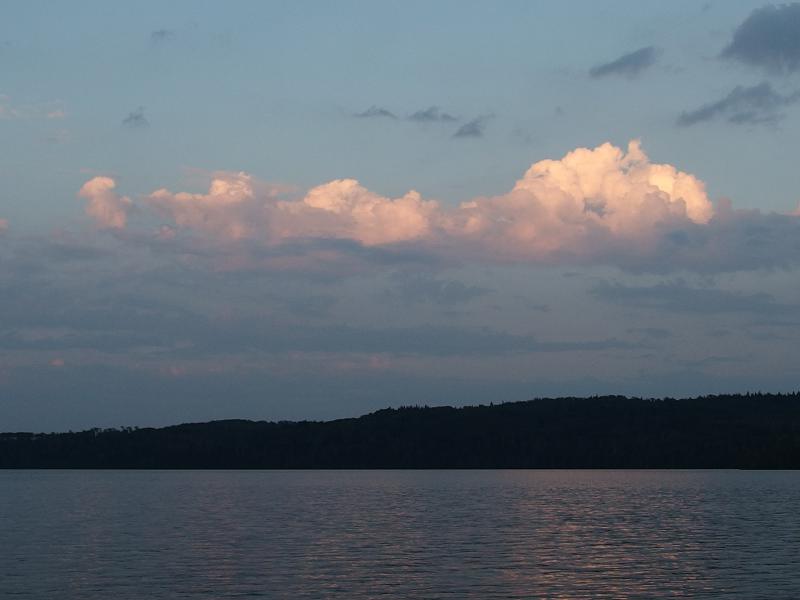
Sunset hues over Mount Saginaw on the far shore
My socializing done for the night I rested and watched the sunset colors light up the clouds. Things began to grow dark ad the sun dropped far on the other side of the island and I eventually stood back up, pumped a fresh liter of water, packed my remaining gear, and then snuggled into my down sleeping bag. I read a bit, couldn't concentrate, and decided to lay there and think.
This was my last night on the island, the last full day, and in twenty-four hours I'd be sleeping in a hotel in Copper Harbor. Not only had I survived the last week, I had followed through (so far) on the planned itinerary and made every destination. I owed a lot of this success to the fair weather, a little bit to my planning, and even more to my bull-headed stubbornness. I wondered what tomorrow would have in store for me. Maybe I'd see two more moose to average out one moose encounter a day. Or maybe there'd be wolves or another fox. Or those thunderstorms could hit with vengeance and leave me stranded twelve miles from Rock Harbor. Those boaters may be my only chance to guarantee catching the ferry in time. I slowly drifted off to sleep, reminiscing on my journey so far and anxious for tomorrow, though a night of heavy downpours and hair-raising lightening strikes would keep me half-awake until the early hours of morning.
-
Jacob Emerick
Oct 4, '15
Ha, I may have a guess on your theory :PMoskey was very pretty. There were a few bad points: no sunset or sunrise views, shelters relatively close together, and some extra traffic from boaters. I'd definitely rate Malone Bay higher (more solitude, shelters spaced out better, and a few small rocky beaches). But if you're debating between Daisy Farm and walking an extra four miles to Moskey it's definitely worth it.
Add to this discussion-
Jacob Emerick
Oct 4, '15
Hi s!I recently upgraded my pad to a 3/4 Klymit, which is not terribly comfortable. My old pad was a giant Alps which, while full length and luxurious, was huge and heavy. I just couldn't fit it in with the rest of my gear on this trip. While the Klymit is a bit hard to sleep on I'm hoping to get more used to it... It rolls up to the size of a Red Bull can and weighs a 6 oz.The lack of sleep is mostly due to my sunburned hands. I've mentioned them a few times in these posts, but they were unbelievable painful. The warm, still air in the early evening and sleeping bag only exacerbated the burn. Often found myself lying awake in pain until 1 or 2 in the morning before drifting into a fitful sleep. Early morning hiking, before the sun was up and when the air was cool and wet, was one of the few reliefs from the hands.Water filter is a MSR Miniworks. A good friend gifted it to me some years back and, while I didn't use it too much before this year, it's turned out to be pretty darn awesome. The filtered water always tastes pretty fresh (unless I'm pulling from a very darkly tainted swamp) and I've yet to get ill from anything.
-
s
Oct 5, '15
Thanks for the information about your equipment. Can you please tell me exactly how you got this sunburn?I am confused as you have been in AZ sun all year. I did not really understand the magnitude of pain this caused;concerned as lack of sleep is cumulative as to problems it can cause. Did you use any painkillers?I have never had a sunburn this bad:could it be as special problem due to the fact this is an island?I take it you did not brush any poisonous plants?You drew water from some pretty mucky areas;I wonder about bacteria from these waters?I have noticed they have found this flesh=eating bacteria in MN.Are you going to review your first aid supplies?
-
Jacob Emerick
Oct 6, '15
The sunburn is something that both my sister and I have suffered from, so I'm guessing that we just have weak genes in that area. Or maybe something environmental from growing up. The biggest factor is the angle of exposure, which is why the trekking poles indirectly caused it. Hiking around Arizona I usually use a long sleeve shirt that shade my hands, but moving forward I'll probably just take to wearing gloves regularly. They'd also help with all the darned cactus needles.First aid supplies - definitely. More band-aids, some cream options, and maybe even second skin for blisters. Though I need to upgrade my gear or just use it. If I had better boots and socks than there would have been no heel issues. And I brought sunscreen and had gloves, just didn't wear them when I should have. This outing really showed me just how much my stubbornness can bite :)
-
s
Oct 7, '15
No wonder I was confused about the extreme nature of the sunburn. We never had sun screen but no one I ever knew had this reaction. Regarding socks,old timber cruiser used 2 pairs of socks with outside pair rolled down to ankles;boots had to be a little large. Most important element was dry feet,so many pairs of socks sent along on long expeditions. Regarding your water filter,looks terrific. The company however does mention that you should also use either boiling or chlorine tablets to take care of viruses. Infection can result in extreme dehydration.Very dangerous on long trip as it can cause mental deterioration,turning you into a vegetable. All things considered you did very,very well.
-
Jacob Emerick
Oct 7, '15
Thanks s. The two-sock thing is something interesting, your article pointed me to some good suggestions about that as well. Wearing one very thin pair and then a larger, padded one outside will keep friction off the skin and prevent most types of blisters.Viruses... yes, that is definitely a concern. Especially in the fetid ponds and creeks of Arizona. I've never worried much about it in Michigan, perhaps not being careful enough thinking that the constant water cycle and fresh mountain creeks would be clean enough, but I think about it a lot in Arizona. Some freshwater drops or even bleach/chlorine would be an easy preventative measure.
-
s
Oct 8, '15
Sorry but I checked again on 2 sock method. It turns out it is the inner sock that is to be rolled down. Have you thought about trying gel inner soles to reduce impact?This also requires larger boots. Any experiments with footwear should of course be tried with short hikes near home. Special chlorine drops are sold by same maker as your filter. Interestingly that site said to draw water from small pools rather than running streams.I have never heard that one before.So did you take aspirin or ibuprofen for the sunburn?
-
Jacob Emerick
Oct 9, '15
Soles actually helped a ton. My boots are rather ancient, getting close to four years old or so, and while they still fit great there is no padding to speak of and the bottoms are cracking off. About six months ago I bought a pair of construction-grade insoles and they feel like brand new boots. While they didn't help with the blisters, they did help with impact.Sunburn was mostly ibuprofen, and sparingly. I didn't bring aspirin (and regretted it) but brought plenty of ibuprofen (for the inevitable muscle pains of backpacking). It didn't make a dent :(
Add to this discussion-
Jacob Emerick
Oct 6, '15
Why eat fresh fish when I had dehydrated chicken and crackers? :P
Add to this discussion-
Jacob Emerick
Oct 7, '15
Alright, now I'm starting to regret it :D
-
Aaron Miner
Oct 7, '15
Well in case you need a reason to come back, you could claim culinary adventuring.
-
Jacob Emerick
Oct 9, '15
That, that sounds like a beautiful reason.
Add to this discussion-
Jacob Emerick
Oct 9, '15
Distance was completely based on the topographic map and I have severe doubts on the accuracy of both that and the mileage on the island's trail markers. On the other hand, my GPS (which I didn't bring along on this trip) has a tendency to overestimate distances due to connection issues. So knowing distances is kinda tough.One thing that was interesting to experience was just how different I felt based on caloric intake. On this day, even after hiking twenty miles, I felt excellent. The last four miles were hard because I was low on food and water by then. If I would have stopped around mile 18 or 19 for a short thirty minute break I probably could have gone even further today. Even with the tough trails and high miles the limiting factor was usually my inexperience.
-
s
Oct 10, '15
Maybe you should take a pedometer on the next long hike. I would guess you may really have added 1/4 to your distance due to elevation changes. Not sure you realize you would be classed as an extreme athlete on this hike. I have lived with an extreme swimmer for forty years. Michael Phelps uses 5000 to 6000 calories per day. I think you should add 500 per day over what you consumed. You need to keep protein high. Did you lose weight?How long did you sleep when you got to Copper Harbor and when you got home?That will tell you how stressed you were. How long to recover from the sunburn?Item of concern is that you did not sleep well.Or is this normal for you?
-
Jacob Emerick
Oct 11, '15
A pedometer sounds like a good idea - saw several hikers out on the island with nice watches that not only tracked their steps, but looked like it has some basic barometer functionalities too. Having some weather forecasting ability would have alleviated plenty of concern and possibly helped with that terrifying last day :)I did lose weight - about 15 lbs. Which was significant. Definitely should have brought more food. Not sure about the extreme athlete (though I do appreciate you classifying me as such), but yeah, there was some stress. Catching up on sleep was definitely needed. Took much of the next week to feel back to normal.
-
s
Oct 12, '15
The terrain on this island was much worse than I expected. I knew you probably did ot have excess weight on you. This means you have to consume a high calorie,high protein diet in order not to begin to digest your own muscle tissue or knee cartilage.You need foods that contain a high level of essential amino acids.Add 700 calories per day. Old lumberjacks always consumed high calorie diets with plenty protein. Remember that the goal is to be in good shape to take your sons hiking with you. This was an extreme weight loss for a short time. Between calorie shortage and the pain you had,your judgment may have been impaired;terrain was too dangerous for that. You were smart to schedule easier days;that helped you get through.This whole trip sounds like my father's WW2 training in Alaska,but they got more food. Some days were like special forces training. The goal should be to come back and recover in one day. Glad you are fine now.
Add to this discussion